Round Rock is lined up for a total solar eclipse April 8, 2024!
That means that the moon will completely cover our view of the sun for a few minutes, called “totality,” creating a miniature sunset and a breathtaking view of the sun’s outer atmosphere, the corona.
During totality, bright stars and planets appear in the sky, the air temperature drops, and animals begin their nighttime routines.
Catch it if you can–the next total eclipse visible from the continental United States won’t be until 2044. Here are some tips to help you host a safe and fun eclipse viewing party.
When is the total eclipse?
The total eclipse will be visible over Round Rock in the afternoon of Monday, April 8, peaking around 1:36 p.m.
Learn more
The moon begins covering the sun at 12:14:45 p.m.
Totality–the time when the moon will cover the entire sun–begins at 1:36:08 p.m., with the maximum eclipse at 1:37:33 p.m. During this totality, you are protected from the sun, and may look directly at it to observe the sun’s corona.
Totality ends at 1:38:57, as the edge of the sun reappears from behind the moon. At this point, it is no longer safe to look at the sun without protection.
The sun will no longer have any part of the moon covering it by 2:59 p.m.
Where can I see the total eclipse?
You can observe the total eclipse anywhere in the path of the eclipse where you have clear skies. Maybe you’ll even want to host a solar eclipse party in a yard or park!
These images show the eclipse’s Path of Totality through Central Texas.


Note: Totality, the total coverage of the sun by the moon, is most exciting part of this eclipse. The length of time in totality will vary according to how close you are to the center of the moon’s shadow.
Round Rock is near the edge of the circle, so our totality lasts just under 2 minutes. Cities closer to the center of the shadow will have totality lasting closer to 4 1/2 minutes.
Learn more
During this brief time of totality, it is safe to look directly at the sun without eye protection. You’ll see something many people say is the most beautiful sight they’ve ever experienced, the sun’s corona. Before and after totality, it is not safe to look directly at the sun without special protective lenses.
If you look carefully at the path of totality, you’ll see areas in east Austin and to the southeast, including Bergstrom International Airport, are not in the path of totality. This means that viewers in those areas must use eye protection at all times if they look towards the sun during the eclipse.
Is there any time I can look towards the sun without eye protection?
If you’re in the path of totality, yes! Here is NASA’s guide for eye safety during the phases of the eclipse:
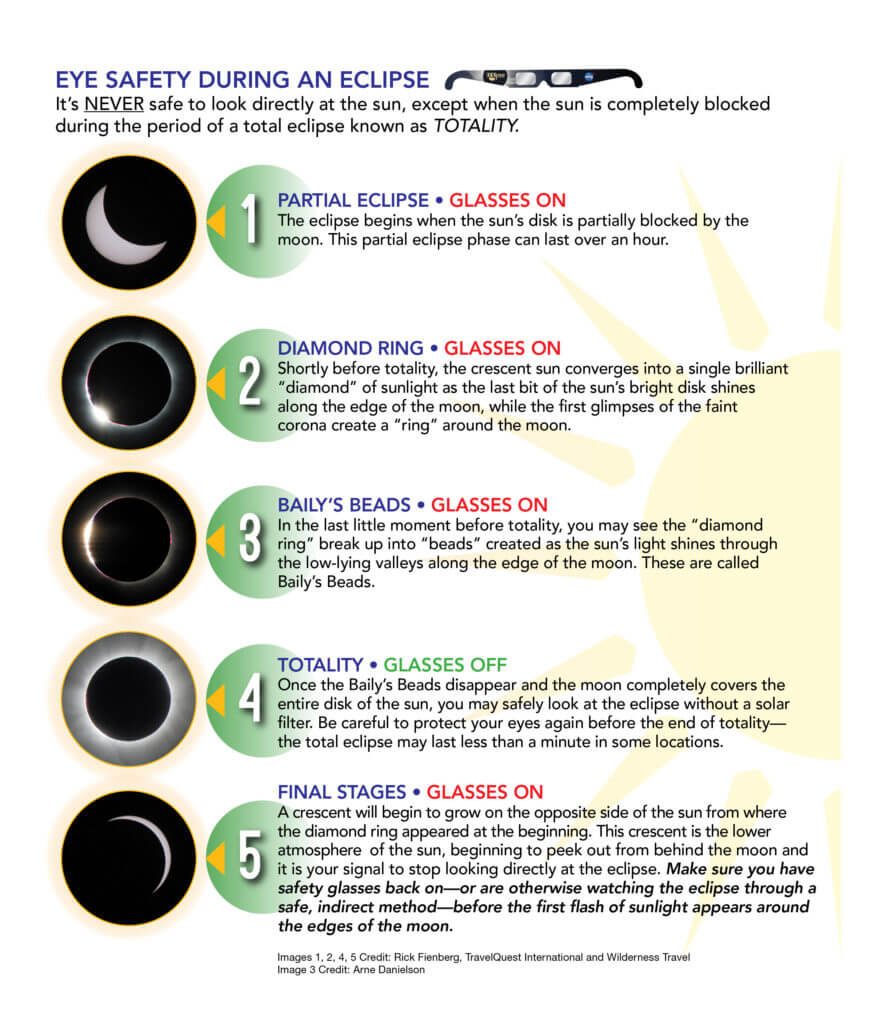
How do I choose eye protection that’s right for me?
An eclipse is a fascinating thing to see, and many people will want to look at the sun at some point during the eclipse.
Looking directly at the sun will cause permanent eye damage unless you are in the path of totality and look during the brief minutes of totality.
SOLAR SAFETY GLASSES (or filters and lenses) that are ISP 12312-2 compliant are one great way to protect your eyes.
Learn more about obtaining solar safety glasses from reputable sources
Specialty lenses or filters reduce visible sunlight to a safe level while also blocking all but a tiny fraction of solar UV and IR radiation. You need both the light reduction and the UV/IR reduction to protect your eyes when you look at the sun.
You may need fewer filters or pairs of glasses than you think. Several people can share a pair of solar safety glasses. Solar eclipses unfold slowly, and you may find it uncomfortable to have your face pointed up at the sky for a long time. Taking turns with a single pair of glasses in a small group feels easy and natural.
Round Rock Public Library gave away 2500 pairs of solar safety glasses before the October 2023 annular eclipse, and we have 2000 additional pairs to give away beginning March 11 thanks to a grant from the Gordon and Betty Moore Foundation, the Space Science Institute, and the NASA Science Mission Directorate.
In addition, online and local retailers will have solar safety glasses you may purchase. Be sure to purchase glasses from a reputable source–don’t put your eyes at risk. In 2017, some vendors put the ISO 12312-2 logo on glasses that had not been certified Here are tips for purchasing safety glasses.
The American Astronomical Society has even more details about assuring you have a safe solar filter.
YOU MAY BE ABLE TO REUSE solar safety glasses that you already own. You’ll need to check that they still offer the protection your eyes need.
Learn more about reusing solar safety glasses or filters
- If the filters are torn, scratched or punctured discard them. You can cover small defects with a bit of duct tape, as long as no light can get through.
- If the filters are coming loose from the cardboard or plastic frames, discard them.
- If the filters are more than 3 years old and are not made to the standards adopted in 2015 (ISO 12312-2:2015), you should discard them. If the filters are less than 3 years old but don’t meet the 2015 standards, avoid staring directly at the sun for more than 3 minutes at a time.
- If you glance at the sun through your solar filter and find it uncomfortably bright, out of focus, and/or surrounded by a bright haze, do not use it. The sun should appear comfortably bright, like a full moon. You should not be able to see anything through the filter other than a bright light.
NASA has a video guide about confirming the safety of any eclipse glasses you may have.
BE WARY OF OTHER VIEWING TECHNIQUES YOU MAY HEAR ABOUT, such as welding helmets or homemade filters.
Learn more about determining whether an eclipse viewing strategy is safe
You may hear about other homemade methods to look at the sun, but these will not offer the protection you need, accoring to guidance from both the American Academy of Ophthalmology and the American Astronomical Society.
Even if they do dim your view of the sun, they do not filter out the entire electromagnetic spectrum of rays that may harm our eyes.
Your retinas do not have pain receptors, so you will not know you are damaging your eyes until after the eclipse, when you develop blind spots or other vision problems.
Ordinary sunglasses (or multiple pairs of sunglasses), neutral density or polarizing filters (such as those made for camera lenses), smoked glass, photographic or X-ray film (unexposed, exposed, or developed), “space blankets,” potato-chip bags, DVDs, and any other materials you may have heard about for solar viewing are not safe.
American Astronomical Society
If you have a welder’s helmet you would like to use for the eclipse, don’t assume any welder’s lens will work. Only helmets rated Shade 12 and higher will provide the protection your eyes need. Many people find the sun uncomfortably bright in a Shade 12 helmet, and too dim in a Shade 15, so look for a Shade 13 or Shade 14.
Note that welding filters give a greenish image of the sun. If you prefer a more natural looking white, yellow, or orange view of the sun, you’ll want to obtain solar safety glasses instead of using a welding helmet.
Can you see the eclipse without looking towards the sun?

Absolutely!
Even if you have a pair of solar safety glasses, you may find it uncomfortable to be looking up at the sun for several hours.
Happily, there are many simple ways to enjoy the eclipse without looking towards the sun.
The easiest way to enjoy the eclipse is simply to notice the small shadows around you, such as those under trees and bushes. Shadows will curve to project images of the sun onto the ground.
But here are other fun techniques to try:
USE A DISCO BALL to splash images of the eclipsing sun all around you. We did!
Learn more about RRPL’s experience when we used disco balls during the October 2023 eclipse
Last summer we saw a research paper about using disco balls as safe ways to view solar eclipses, so we tried it during the October 2023 annular eclipse. Then we added our results to a new research paper that came out in March 2024.
It was such a fun way to display the eclipse and keep up with what was happening in the sky when we weren’t looking through solar safety glasses.
Simply set up a disco ball where it catches the sunshine, preferably several yards away from a shaded wall, and enjoy the show by looking at the reflections the disco ball casts onto walls, the ground, the ceiling, and even onto people!
During the annular eclipse in October, we had one disco ball inside a sun-facing window casting images across the 3rd floor, and a second disco ball in the Discovery Garden casting images on all the outdoor walls and across the width of the 2nd floor to the reference desk. The images farthest from the disco ball were as large as 4″.
And of course, every disco ball needs fun music, so we made an eclipse-themed playlist you can access with your library card through our Freegal service.
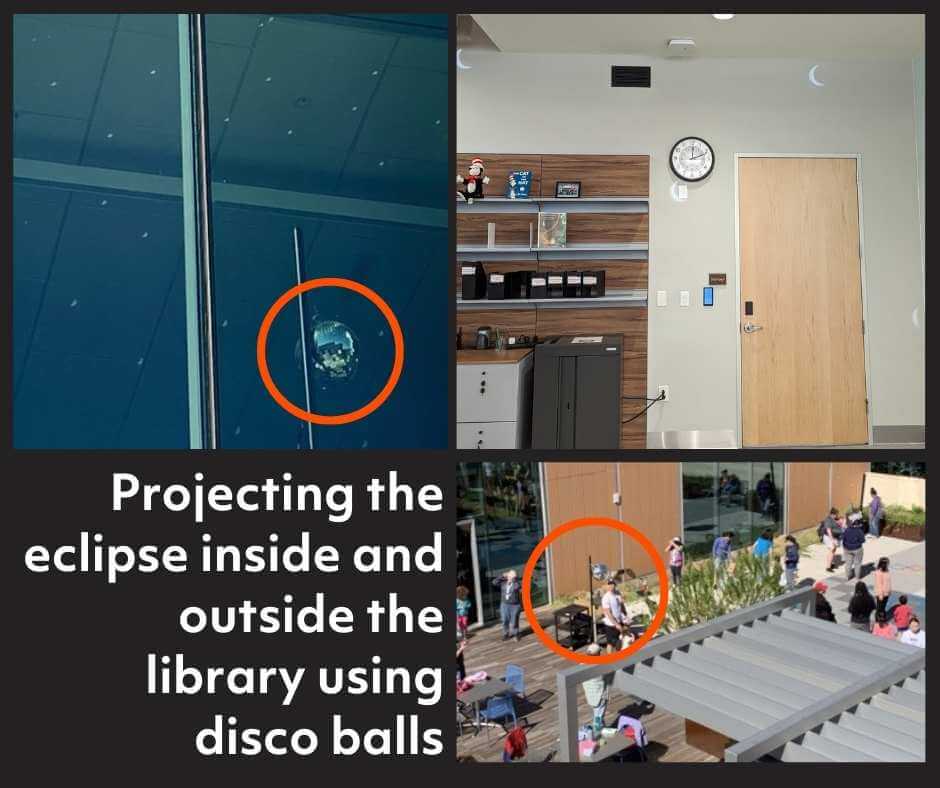
LET THE SUN SHINE THROUGH SMALL HOLES and look at the pattern on the ground.
Learn more about this cheap and easy way to watch the eclipse
Make the simplest version of a lens by creating small holes that light can pass through. You might:
- Punch a hole in a piece of paper or cardstock (hint: a larger piece of paper casts a larger shadow, which may make it easier to see the image of the sun inside the shadow).
- Grab the kitchen colander and let light shine through the holes and onto the ground
- Simply criss-cross your fingers so there are little holes between them.
No matter which technique you try, align the holes with the angle of the sun, and look at the ground.
You’ll see an image of the eclipsing sun on the ground where the light is passing through the holes.

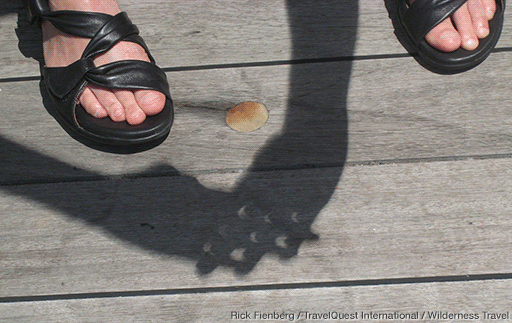
MAKE A PINHOLE VIEWER with a cardboard box.
Learn how
This strategy is the same idea as projecting the sun through a small hole, but you also build a dark box to give you a high-contrast view of the eclipse.
We like this set of instructions, but you’ll find many of them on the internet. Pinhole viewers make small images, but if you choose a long box, you’ll see a larger image.
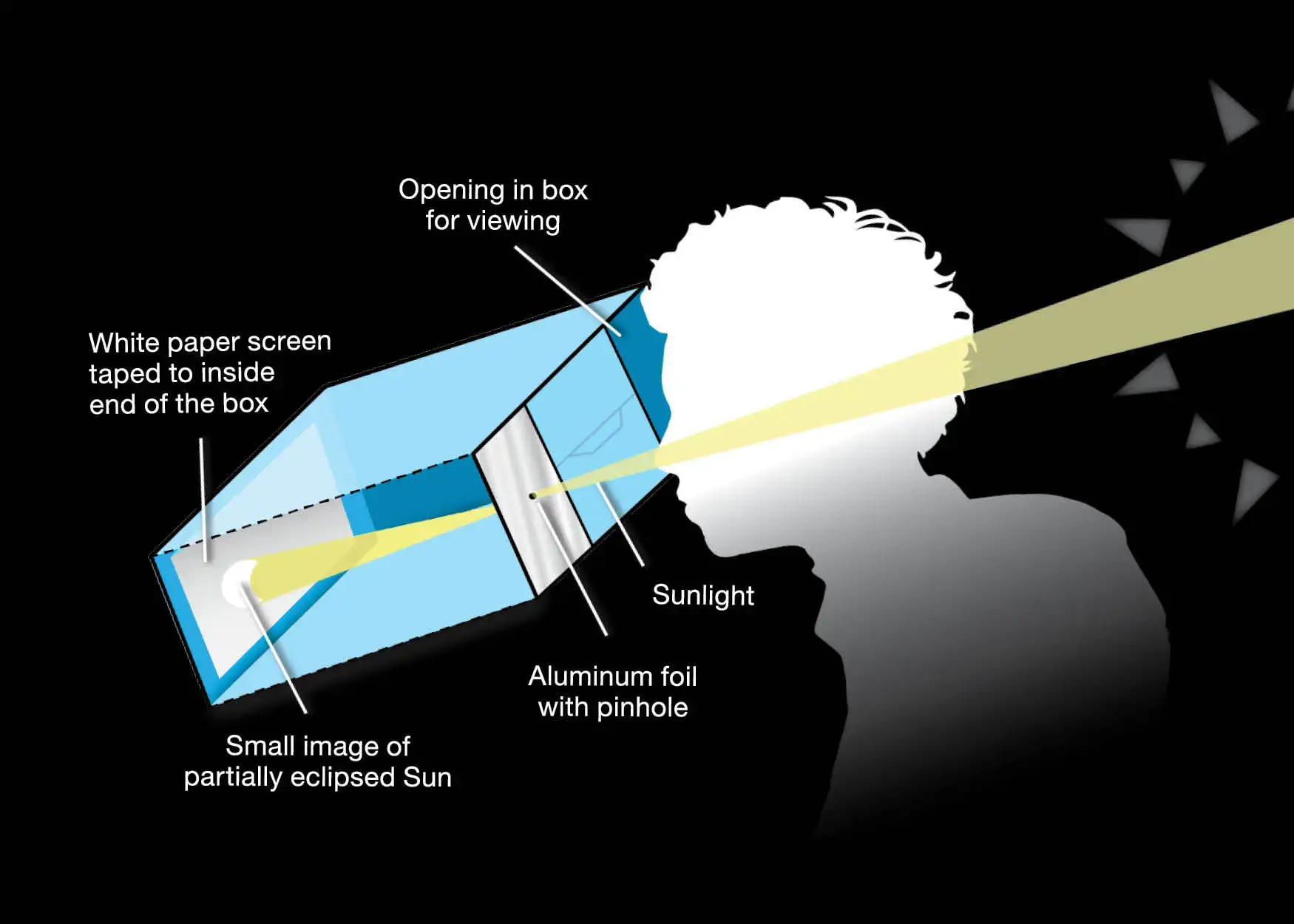
BUILD A SAFE SOLAR VIEWER using lenses to make large images that many people can view at the same time.
We made some using simple plans from the College of Charleston. You’ll need to plan ahead a little, but the results are worth it.
Get the plans and see what we made
For the October 2023 eclipse, we made two of the designs developed by Dr. Terry Richardson from the College of Charleston.
For a large image comfortable for many people to view at the same time, we highly recommend the 2-Lens Safe Solar Viewer (SSV). We purchased the lenses as a special set specifically for this design from Surplus Shed.
We also made Dr. Richardson’s design that uses a single lens from an old pair of reading glasses. It was so easy and cheap to build. It created a nice, clear image, although it was much smaller than the 2-lens Safe Solar Viewer’s image.

Is an eclipse dangerous?
The only danger an eclipse poses is that we are tempted to look directly at the sun to see this unusual sight.
Unless you are looking directly at the sun, it’s a day with the normal safety risks that you would experience anytime you are outside.
In fact, if you have solar safety glasses, you should not wear them unless you are looking at the sun. Solar safety glasses block so much light that they are not safe to wear while you are walking or driving.

